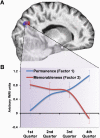A central role for the retrosplenial cortex in de novo environmental learning
- PMID: 26284602
- PMCID: PMC4559753
- DOI: 10.7554/eLife.09031
A central role for the retrosplenial cortex in de novo environmental learning
Abstract
With experience we become accustomed to the types of environments that we normally encounter as we navigate in the world. But how does this fundamental knowledge develop in the first place and what brain regions are involved? To examine de novo environmental learning, we created an 'alien' virtual reality world populated with landmarks of which participants had no prior experience. They learned about this environment by moving within it during functional MRI (fMRI) scanning while we tracked their evolving knowledge. Retrosplenial cortex (RSC) played a central and highly selective role by representing only the most stable, permanent features in this world. Subsequently, increased coupling was noted between RSC and hippocampus, with hippocampus then expressing knowledge of permanent landmark locations and overall environmental layout. Studying how environmental representations emerge from scratch provided a new window into the information processing underpinning the brain's navigation system, highlighting the key influence of the RSC.
Keywords: fMRI; human; navigation; neuroscience; virtual reality.
Conflict of interest statement
The authors declare that no competing interests exist.
Figures







References
Publication types
MeSH terms
Grants and funding
LinkOut - more resources
Full Text Sources

